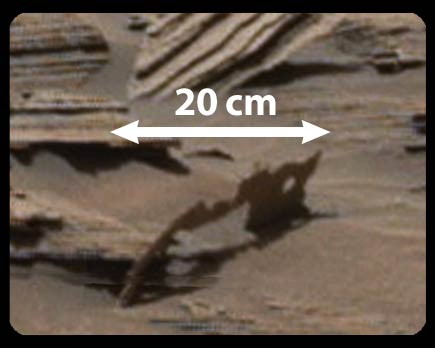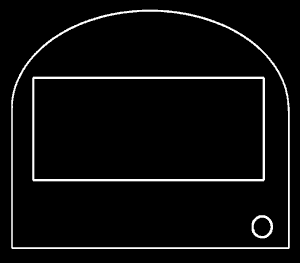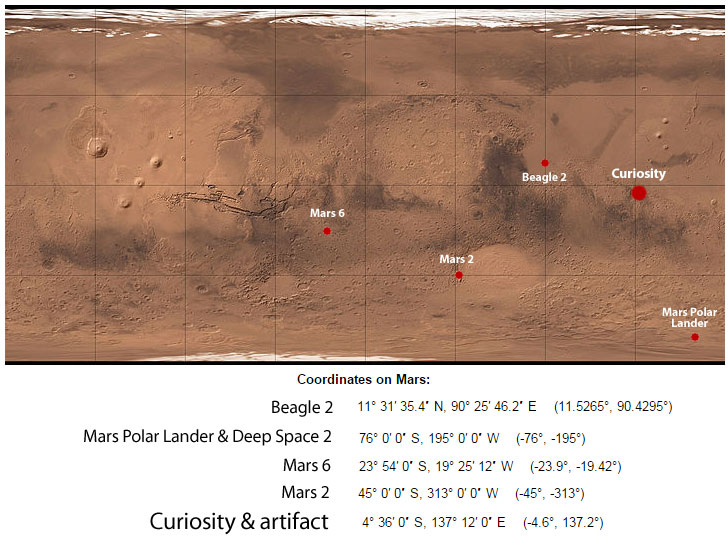 Vlad's
Science Corner
Vlad's
Science Corner 
Brought to you by the Psychic Energy Lab at Triplotz University, Potzderanja
Dec. 5, 2015
Hello everyone !
Today we we return to the NASA panoramic photo we observed in September, made by Curiosity our American colleague's fabulous rover on Mars, in which we discovered a strange quantic phenomenon. (see September issue) The original photo can still be seen HERE on the NASA website. Our Nasa colleagues have still not answered our query about the twin rocks and this lack of a prompt response is quite preoccupying, because it means they are probably trying to hush up this major discovery. As they usually are quick to reply and discuss scientific issues with me, it just well may be that they have been coerced to silence by the powerful and secretive US military powers for reasons we have yet to fathom. We can easily imagine that the duplicated rocks we discovered may well have sparked great interest amongst the scientists and researchers working for their armement industry, who would surely love to develop technology enabling the instant cloning of tanks, missiles and other deadly artefacts...
But it's another strange artefact that caught my eye this month as I was studying the same area in the photography...
By passing your mouse over the above image you will see a highlighted zone on the left. Below is an enlargment of this area.
Just below the area where the twin rocks appeared, I've noticed a very thin slab of material, the nature of which is very hard to determine. The geological stratas of the minerals surrounding it first made me think it was a layer of rock but a second look cast a strong doubt on this explanation. The thin slice is tilted at a very different angle from the others and it's singularity makes it look more like a corroded metal plate stuck in the ground. If it were a slab of the same neighboring sandstone laminations, the eroding powers at work on Mount Sharp would surely have destroyed it. The fact that it stands upright and resists them seems to corroborate the suggestion it must be made of a more solid material such a some kind of metal. But by admitting the slice's metallic nature, we enter a field rife with stupendous implications. Because in its natural state metal is not usually (if ever) found in such perfectly plane slices. To manifest such a perfect planar aspect, a metal has to be manufactured ! But then who could have done so ? Only two possibilities : it's either man made (we know that several unsuccessful probes have crashed on Mars, see here) and part of the debris from an older martian exploration campaign or.... Could this artifact be proof that an alien civilisation was once before on present on Mars ? ? ? Either way it's well worth a closer inspection. Of course I've once again notified NASA of this incredible phenomenon and eagerly await their input, though I doubt we ever receive an answer as the whole area has probably already been declared a classified zone...
Scientifically yours,
Vlad

Dec. 6, 2015
Still studying the strange martian slice. NASA's scale indications set this object's apparent lenght (height? width ?) at approximately 20cm. This could lead one to imagine it might have been a part of a control board from some kind of craft...



P.S.:
So what do you think of this new amazing discovery from the P.E.L. ? Earth
made or alien ?
Any theories on what it might be ? Don't forget to share your own thoughts
and ideas with us at potzderanja.edu at free.fr
Scientifically yours,
Vlad
Dec. 7, 2015
While
we wait for NASA's reply concerning our discovery, I've decided to make
some inquiries of my own to determine what this odd slab might be.
First let us try to determine what it's made of.
1- The slab is a mineral slice of sandstone like the other lamination layers around it. I tend to want to dismiss this possibility for the reasons I previously mentioned. The angle of the slab is totally different from the ones surrounding it. It's very thin which makes it unlikely to resist the eroding factors at work on the martian surface. It looks like it's stuck in the ground and that a large part of it is hidden from view.
2- The slab is not sandstone and it is made of a more resistant material like some kind of metal or a composite material strong enough to withstand the rigors of the Martian climate. In this case its very planar aspect points to a manufactured object as metal is not naturally found in perfectly flat sheets as far as I know. The jagged edges and and its general aspect point towards an eroded metal plate similar to the corroded oil drum on the photo shown on the right.

If we admit this is a corroded manufactured metal sheet, then we must necessarily ask ourselves by whom it was manufactured. Once again two possibilities arise.
1-
It's a man made object. This seems at first the most probable solution
as we know that since the seventies at least 7 space craft and probes
have crashed on Mars. These mission failures, added to all the spacecraft
that never made it to their destination and the lost Phobos probes sent
to the homonymous martian moon, have even led some to speak of a "Martian
Curse" , though more recent missions showing a much greater success
rate seem to have lifted this hex on Martian explorations.
We'll concentrate on the failed missions leading to crashed objects of
the Martian surface. They are in chronological order :
1970 Soviet Space Program
Mars 2
1973 Soviet Space Program Mars
6
1992 NASA Mars Observer
1998 NASA
Mars Climate Orbiter
1999 NASA Mars
Polar Lander & Deep
Space 2
2003 ESA Beagle 2
A
study of these missions (see for example this
page) shows that the Soviet Mars 2 and Mars 6 crashed craft are very
far away from Curiosity, so is NASA's 1999 Polar Lander projected crash
site. ESA's Beagle 2 is closer but still 2900 km away. So we can rule
out all theses missions. Three possibilities remain :
-Communications
witn NASA's 1992 Mars Observer craft were mysteriously lost 3
days before its orbital insertion around Mars. Though unlikely, it is
possible that the mute craft continued its mission and attained the Red
Planet.
-NASA's 1998 Mars Climate Orbiter disintegrated in the Martian
atmosphere due to a misconception in measuring instruments (a mix up between
metric and non metric measuring systems !) and because of Mars' thin atmosphere
some debris may have reached the surface.
-Launched from
the Mars Polar Lander before it crashed, two Deep Space 2 probes
reached the Martian surface. Communications were not established with
either one and their whereabouts are unknown though they should not have
landed very far from their mother ship's crash site.
All things considered and though no trace of the Mars Polar Lander has
been spotted by orbiting Mars surveyors at its projected crash site, the
two Deep Space 2 lost probes are too small to be seen anyway and that
there's a minute possibility that Mars Observer reached the surface, the
least unlikely theory would point to a part from NASA's 1998 Mars Climate
Orbiter. Its desintegration in the atmosphere could have led to debris
being scattered over a large area and might explain the battered aspect
of this lone object.
2- Another possibility cannot be ruled out... That this object is not man made ! If so, it is the first occurence of an alien manufactured object known to humanity ! Well worth a U-turn no ? What do you say NASA people ?
Scientifically yours,
Vlad


Mars
Climate Orbiter

